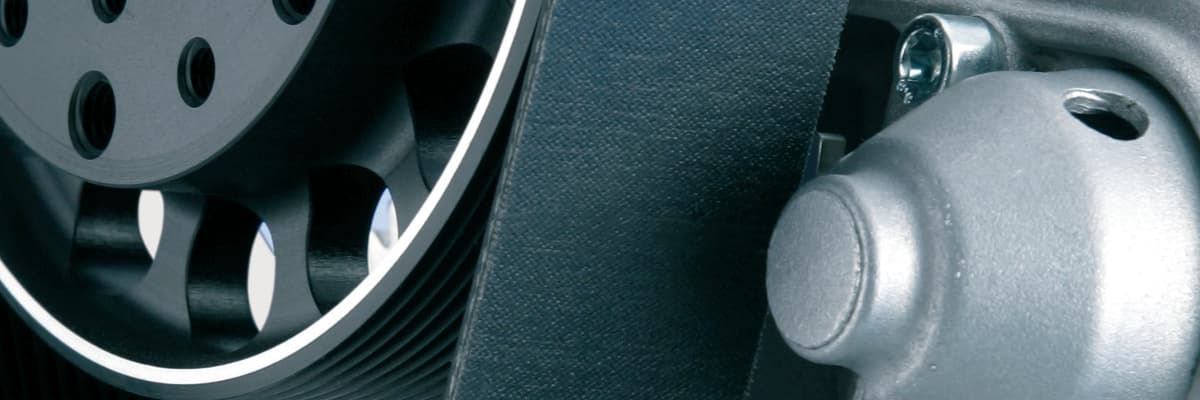What Is the Maximum Circumferential Speed of Belts?
Increasing machine efficiency requires an increase to rotational speed. The main criterion, for any given belt type or chain used, is circumferential speed.
Assessing only rotational speed is not enough.
For rotational speed alone, the diameter of the wheel or pulley (which will carry out such performance) must be always taken into account.
Circumferential speed is calculated according to this formula:
This formula shows that, for example, if we have a hand plane with a rotational speed of 10,000 rpm/min and a small diameter pulley of 20 mm, the resulting circumferential speed is 10.47 m/s. Conversely, a compressor with a rotational speed of 1,500 rpm/min and a pulley with a diameter of 530 mm results in a circumferential speed of 41.64 m/s!
It is necessary to adjust the force, as listed in the chart, by pressing the middle of the belt span to check belt deflection force. If deflection is too large, it is imperative that the belt tension be tightened; if it is too small, loosening belt tension will decrease the belt deflection force. This measurement, however, is only a test and does not give an accurate result. Still, this is much better than no estimated measurement at all. See device user guides and their descriptions.
Belt Use According to Maximum Circumferential Speed
- Sheathed belts are suitable for speeds only up to 35 m/s.
- Raw-edged V-belts with inner cogs XPZ, XPA, XPB, XPC and ZX, AX, BX, and CX can handle speeds of up to 50 m/s. There exists applications where these belts can operate at speeds over 50 m/s, e.g. blowers at 60 m/s. It is, however, necessary to make accurate calculations, perform testing, and provide sufficient balance (the latter particularly applies to drives that use VTP, a special pulley made of ductile cast iron).
- Ribbed belts can operate with a max. speed of up to 60 m/s. These belts can successfully replace V-belts in cases of high-speed drive applications.
- Timing belts are designed for max. speed according to profile size, 40-50 m/s. CONTI SYNCHROFORCE CXP and Extreme are special types, and can work up to 60 m/s. For timing belts, during high rotational speeds, it is necessary to monitor noise level. Belt profiles STD or CTD are designed for the highest speeds.
- CXA special timing belts are intended for low-speed transmissions. The design and material of these belts are limited to a circumferential speed, max. 25 m/s. These belts are designed for other types of high-speed drives.
- Flat belts can be used according to belt type for max. speeds of 80-100 m/s. The disadvantage, however, is lower transmitted power, greater width, and the need for higher tension force.
- For comparison, chain drives may be used depending on the size and type of chain, for max. speeds of about 20 m/s. It is important to ensure proper lubrication and to comply with all the design requirements of chain manufacturers.
Balancing of the Pulleys for High Speed Applications
The higher the circumferential speed, the greater the requirements for pulley design - even the overall equipment. It is necessary to balance the pulley at a precise balance quality grade, e.g. Q 4 – Q 2.5.
Choice of Pulley Material and Construction
It is also necessary to choose a suitable material, e.g. steel or cast steel, rather than cast iron (which is not suitable for V- and timing belts at speeds above 45 m/s and 35 m/s, respectively). The structure also produces greater centrifugal force; therefore it is important to select a more sturdy construction.
How to Reduce the Drive’s Operating Circumferential Speed?
As demonstrated in the formula, the rate of speed is decisively influenced by circumferential speed and pulley diameter.
- When using V-belts, choose new and modern types rather than classic. V-belts with inner cogs have greater flexibility, require less of a min. pulley diameter, and are capable of higher power transmission. Equally, drives can get by with fewer belts or even significantly smaller pulley diameters.
- Replace V-belts by ribbed belts, which have smaller pulley diameter, greater flexibility, and can transmit higher circumferential speeds.
- In the application of timing belts, use higher performance types, such as CXP, which transmit greater power and speed. It then becomes possible to use smaller pulley diameters and reduce the overall size of the drive.


